climate control Alfa Romeo 156 2004 Owner handbook (in English)
[x] Cancel search | Manufacturer: ALFA ROMEO, Model Year: 2004, Model line: 156, Model: Alfa Romeo 156 2004Pages: 357, PDF Size: 5.04 MB
Page 118 of 357
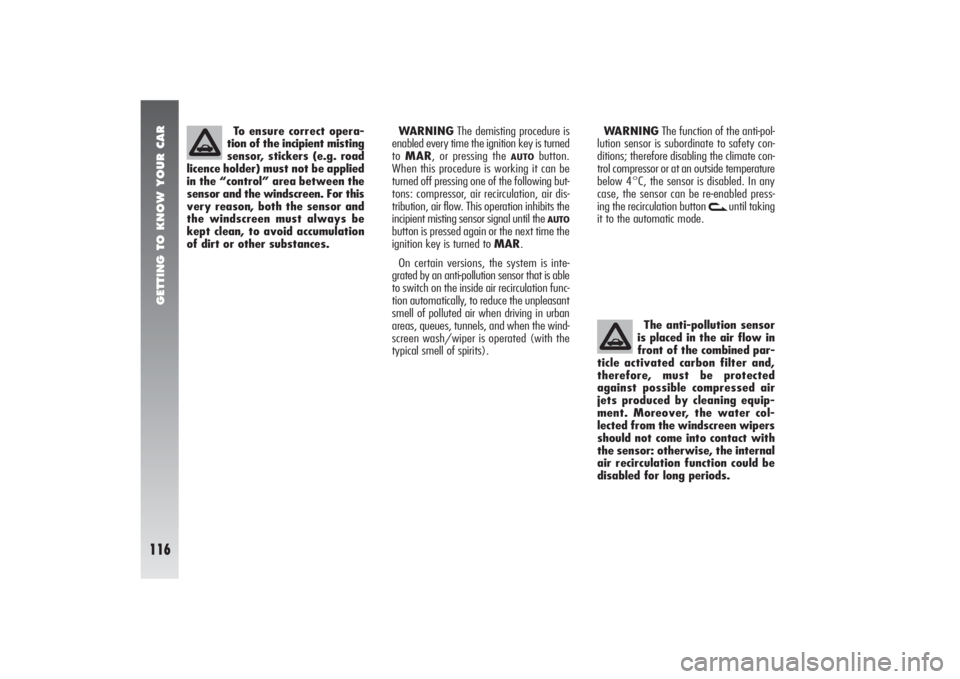
GETTING TO KNOW YOUR CAR
116
The anti-pollution sensor
is placed in the air flow in
front of the combined par-
ticle activated carbon filter and,
therefore, must be protected
against possible compressed air
jets produced by cleaning equip-
ment. Moreover, the water col-
lected from the windscreen wipers
should not come into contact with
the sensor: otherwise, the internal
air recirculation function could be
disabled for long periods.
WARNINGThe demisting procedure is
enabled every time the ignition key is turned
to MAR, or pressing the
AUTO
button.
When this procedure is working it can be
turned off pressing one of the following but-
tons: compressor, air recirculation, air dis-
tribution, air flow. This operation inhibits the
incipient misting sensor signal until the AUTO
button is pressed again or the next time the
ignition key is turned to MAR.
On certain versions, the system is inte-
grated by an anti-pollution sensor that is able
to switch on the inside air recirculation func-
tion automatically, to reduce the unpleasant
smell of polluted air when driving in urban
areas, queues, tunnels, and when the wind-
screen wash/wiper is operated (with the
typical smell of spirits).WARNINGThe function of the anti-pol-
lution sensor is subordinate to safety con-
ditions; therefore disabling the climate con-
trol compressor or at an outside temperature
below 4°C, the sensor is disabled. In any
case, the sensor can be re-enabled press-
ing the recirculation button
v
until taking
it to the automatic mode. To ensure correct opera-
tion of the incipient misting
sensor, stickers (e.g. road
licence holder) must not be applied
in the “control” area between the
sensor and the windscreen. For this
very reason, both the sensor and
the windscreen must always be
kept clean, to avoid accumulation
of dirt or other substances.
Page 119 of 357

GETTING TO KNOW YOUR CAR
117
The air quality control is also entrusted
to a combined particle and activated carbon
filter.
The climate control system automatically
controls and adjusts the following parame-
ters and functions:
– temperature of the air admitted to the
passenger compartment (for the driver’s and
passenger’s side separately)
– fan speed
– air distribution
– inside air recirculation on/off
– climate control compressor on/off en-
able.The settings of the following functions can
be modified manually:
– fan speed
– air distribution
– inside air recirculation on/off
– climate control compressor on/off en-
able
– window defrosting/demisting.
The control of the functions that have not
been modified manually will always be au-
tomatic and, in any case, the temperature
of the air flowing into the passenger com-
partment is controlled automatically de-
pending on the temperatures set on the dri-
ver’s and passenger’s displays.WARNINGManual selections prevail
over automatic ones and remain in storage
until the user decides to resume automatic
control. The settings selected manually are
stored when the engine is switched off and
resumed the next time the engine is started.
Page 120 of 357
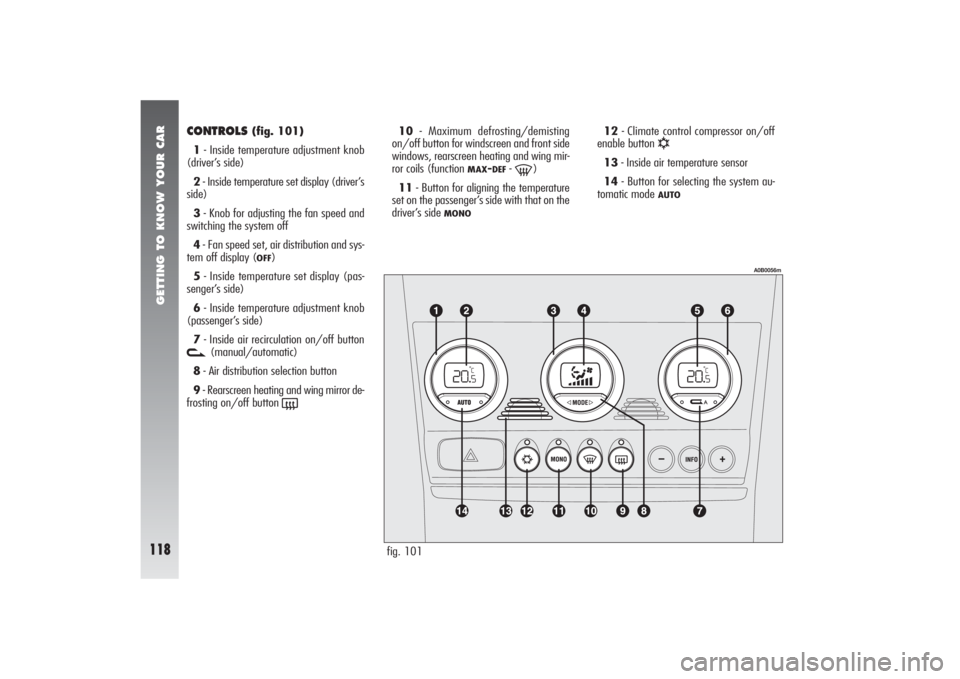
GETTING TO KNOW YOUR CAR
118
CONTROLS
(fig. 101)
1- Inside temperature adjustment knob
(driver’s side)
2- Inside temperature set display (driver’s
side)
3- Knob for adjusting the fan speed and
switching the system off
4- Fan speed set, air distribution and sys-
tem off display (OFF
)
5- Inside temperature set display (pas-
senger’s side)
6- Inside temperature adjustment knob
(passenger’s side)
7- Inside air recirculation on/off button
v
(manual/automatic)
8- Air distribution selection button
9- Rearscreen heating and wing mirror de-
frosting on/off button
(
10- Maximum defrosting/demisting
on/off button for windscreen and front side
windows, rearscreen heating and wing mir-
ror coils (function
MAX
-DEF
- -
)
11- Button for aligning the temperature
set on the passenger’s side with that on the
driver’s side
MONO
12- Climate control compressor on/off
enable button
√
13- Inside air temperature sensor
14- Button for selecting the system au-
tomatic mode
AUTO
fig. 101
A0B0056m
Page 121 of 357
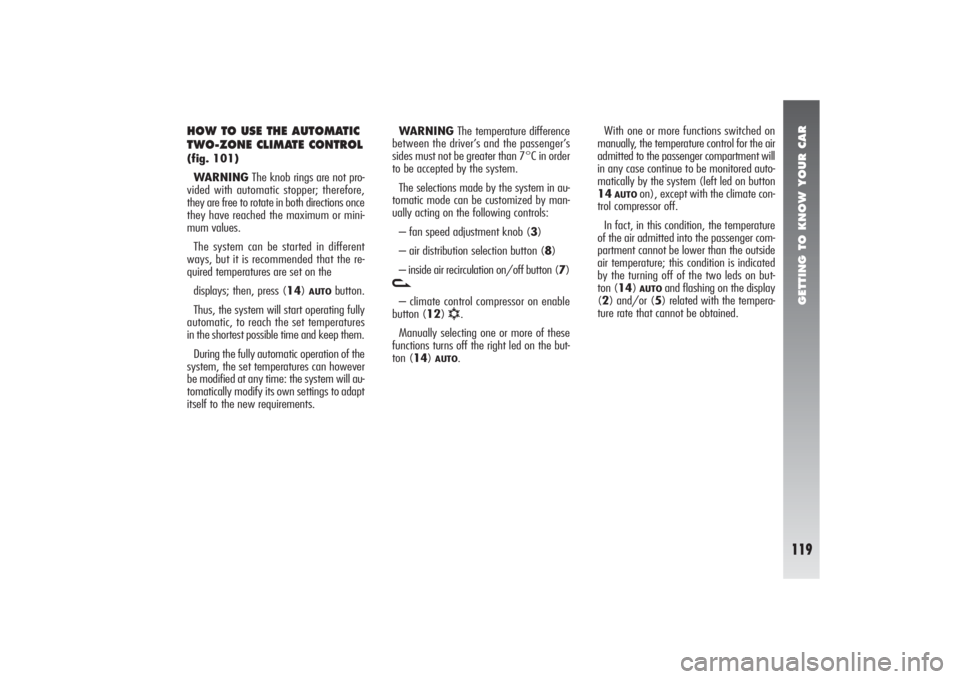
GETTING TO KNOW YOUR CAR
119
HOW TO USE THE AUTOMATIC
TWO-ZONE CLIMATE CONTROL(fig. 101)
WARNINGThe knob rings are not pro-
vided with automatic stopper; therefore,
they are free to rotate in both directions once
they have reached the maximum or mini-
mum values.
The system can be started in different
ways, but it is recommended that the re-
quired temperatures are set on the
displays; then, press (14)
AUTO
button.
Thus, the system will start operating fully
automatic, to reach the set temperatures
in the shortest possible time and keep them.
During the fully automatic operation of the
system, the set temperatures can however
be modified at any time: the system will au-
tomatically modify its own settings to adapt
itself to the new requirements.WARNINGThe temperature difference
between the driver’s and the passenger’s
sides must not be greater than 7°C in order
to be accepted by the system.
The selections made by the system in au-
tomatic mode can be customized by man-
ually acting on the following controls:
– fan speed adjustment knob (3)
– air distribution selection button (8)
– inside air recirculation on/off button (7)
v– climate control compressor on enable
button (12)
√
.
Manually selecting one or more of these
functions turns off the right led on the but-
ton (14)
AUTO
.With one or more functions switched on
manually, the temperature control for the air
admitted to the passenger compartment will
in any case continue to be monitored auto-
matically by the system (left led on button
14
AUTO
on), except with the climate con-
trol compressor off.
In fact, in this condition, the temperature
of the air admitted into the passenger com-
partment cannot be lower than the outside
air temperature; this condition is indicated
by the turning off of the two leds on but-
ton (14) AUTO
and flashing on the display
(2) and/or (5) related with the tempera-
ture rate that cannot be obtained.
Page 124 of 357
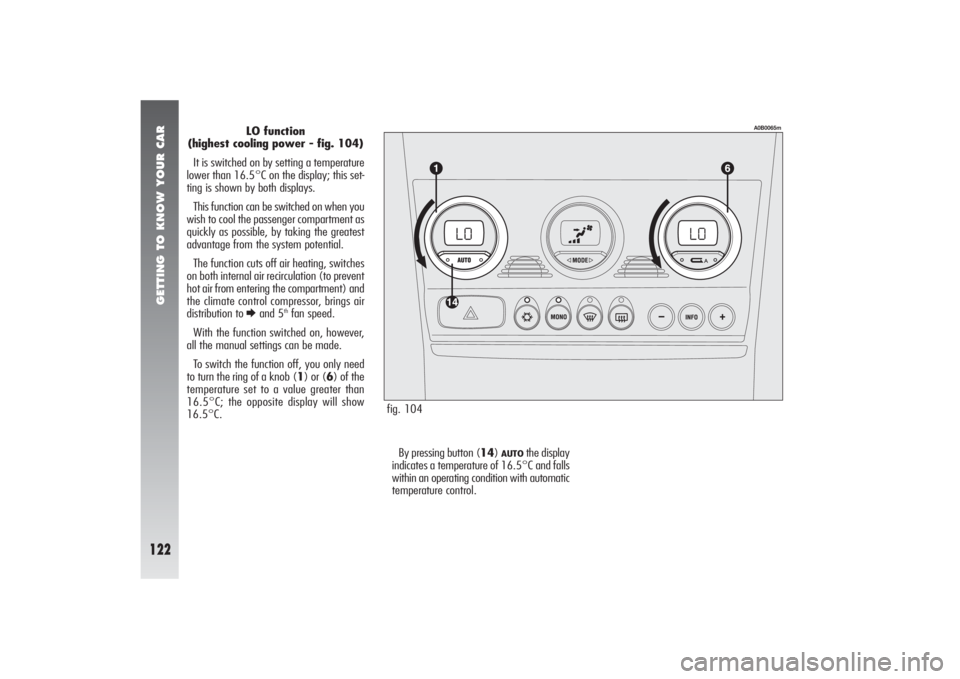
GETTING TO KNOW YOUR CAR
122
LO function
(highest cooling power - fig. 104)
It is switched on by setting a temperature
lower than 16.5°C on the display; this set-
ting is shown by both displays.
This function can be switched on when you
wish to cool the passenger compartment as
quickly as possible, by taking the greatest
advantage from the system potential.
The function cuts off air heating, switches
on both internal air recirculation (to prevent
hot air from entering the compartment) and
the climate control compressor, brings air
distribution to E
and 5
thfan speed.
With the function switched on, however,
all the manual settings can be made.
To switch the function off, you only need
to turn the ring of a knob (1) or (6) of the
temperature set to a value greater than
16.5°C; the opposite display will show
16.5°C.
fig. 104
A0B0065m
By pressing button (14)
AUTO
the display
indicates a temperature of 16.5°C and falls
within an operating condition with automatic
temperature control.
Page 126 of 357

GETTING TO KNOW YOUR CAR
124
FAN SPEED ADJUSTMENT
KNOB
(fig. 106-107)
Turning the ring of knob (3), clockwise
or counterclockwise will cause the fan speed
- and, therefore, the amount of air flowing
into the passenger compartment - to in-
crease or decrease, respectively; the 16
speeds that can be selected are displayed
by a bar (every 3 clicks), up to a maximum
of 6 illuminated bars:
– max. fan speed = all bars lit;
– min. fan speed = one bar lit.
The fan can be cut off (all bars off) only
if the climate control compressor has been
switched off by pressing button (12)
√
.
To resume automatic fan speed control af-
ter a manual setting has been made, press
button (14)
AUTO
. By fully turning the ring
of knob (3) counterclockwise, the system
will be turned off, with the following situa-
tion: display (2) OFF; display (5) OFF; cen-
tral display (4) OFF and left-hand led avail-
able on internal air recirculation button (7)
v
ON and both led on AUTO button
switch OFF.WARNINGBy pressing the internal air
recirculation button (7)
v
, it is possible
to let external fresh air into the passenger
compartment.
fig. 106
A0B0067m
Page 129 of 357
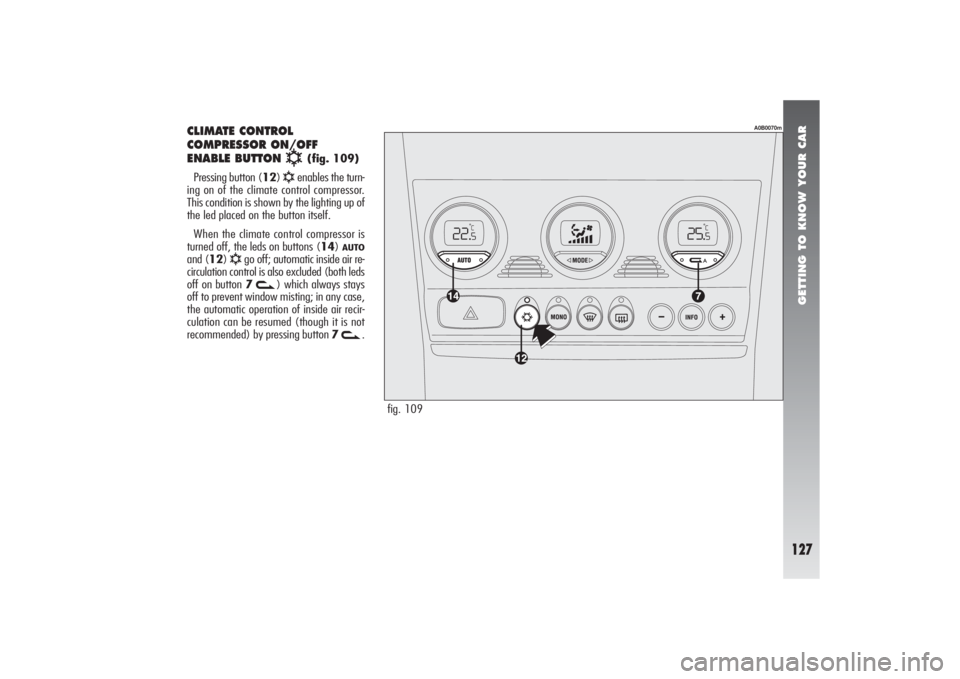
GETTING TO KNOW YOUR CAR
127
CLIMATE CONTROL
COMPRESSOR ON/OFF
ENABLE BUTTON
√
(fig. 109)
Pressing button (12)
√
enables the turn-
ing on of the climate control compressor.
This condition is shown by the lighting up of
the led placed on the button itself.
When the climate control compressor is
turned off, the leds on buttons (14)
AUTO
and (12)
√
go off; automatic inside air re-
circulation control is also excluded (both leds
off on button 7
v
) which always stays
off to prevent window misting; in any case,
the automatic operation of inside air recir-
culation can be resumed (though it is not
recommended) by pressing button 7
v
.
fig. 109
A0B0070m
Page 130 of 357

GETTING TO KNOW YOUR CAR
128
When the climate control compressor is off,
it is not possible to admit air to the pas-
senger compartment with a temperature be-
low the outside temperature; in this case,
the value flashes on the display concerning
the temperature that cannot be reached
and the left led on button (14
AUTO
-
fig. 110) goes off.
The switching off of the climate control
compressor remains in storage even when
the engine has been stopped. To resume au-
tomatic control for switching on the climate
control compressor, press button (12) √
again, the button led will turn on, or press
button (14)
AUTO
; in which case, the other
manual settings set will be cancelled.
fig. 110
A0B0071m
Operation of the climate
control compressor is nec-
essary for cooling and dehumidify-
ing the air; it is advisable to keep
this function always on, to prevent
window misting problems.
WARNING
Page 132 of 357

GETTING TO KNOW YOUR CAR
130
With the outside temper-
ature below 2°C the cli-
mate control compressor is unable
to work. It is therefore inadvisable
to use the inside air recirculation
function v
with low outside tem-
perature as windows may mist
over quickly.WARNING
The inside air recirculation
function makes it possible
to reach the required “heating” or
“cooling” conditions faster. It is
however inadvisable to use it on
rainy/cold days as it would con-
siderably increase the possibility of
the windows misting inside, espe-
cially if the climate control system
is off.
WARNING
It is advisable to turn on the
inside air recirculation sys-
tem in queues or tunnels to avoid
admitting polluted air from outside.
The prolonged use of this function
should however be avoided, espe-
cially with several persons on
board, to avoid the possibility of the
windows misting inside.
WARNING
In certain weather condi-
tions (e.g. outside temper-
ature around 0°C) and with auto-
matic air recirculation control on,
mist may form on the windows. In
this case press the inside air re-
circulation button (7)
v
, to
switch off recirculation (leds on
button off) and if necessary in-
crease the flow of air to the wind-
screen.
WARNING
Page 134 of 357
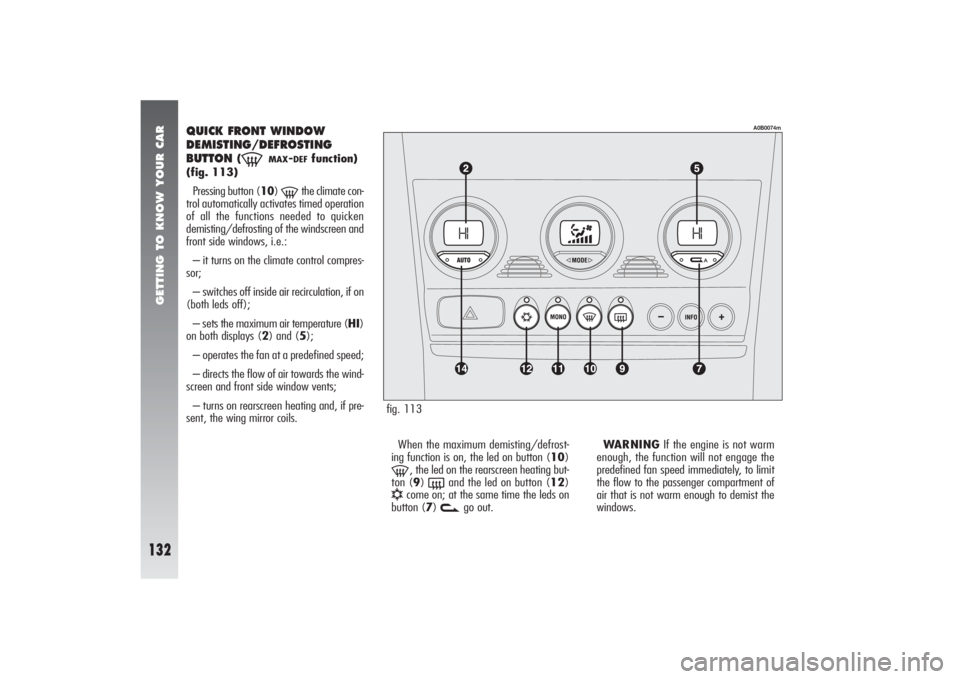
GETTING TO KNOW YOUR CAR
132
fig. 113
A0B0074m
QUICK FRONT WINDOW
DEMISTING/DEFROSTING
BUTTON
(-
MAX
-DEF
function)
(fig. 113)
Pressing button (10)
-
the climate con-
trol automatically activates timed operation
of all the functions needed to quicken
demisting/defrosting of the windscreen and
front side windows, i.e.:
– it turns on the climate control compres-
sor;
– switches off inside air recirculation, if on
(both leds off);
– sets the maximum air temperature (HI)
on both displays (2) and (5);
– operates the fan at a predefined speed;
– directs the flow of air towards the wind-
screen and front side window vents;
– turns on rearscreen heating and, if pre-
sent, the wing mirror coils.
When the maximum demisting/defrost-
ing function is on, the led on button (10)
-
, the led on the rearscreen heating but-
ton (9)
(
and the led on button (12)
√
come on; at the same time the leds on
button (7)
v
go out.WARNINGIf the engine is not warm
enough, the function will not engage the
predefined fan speed immediately, to limit
the flow to the passenger compartment of
air that is not warm enough to demist the
windows.